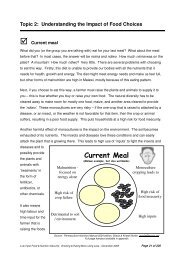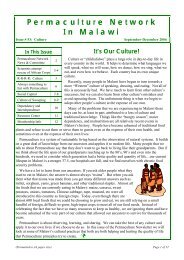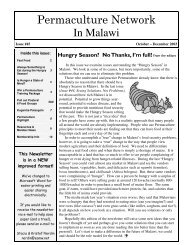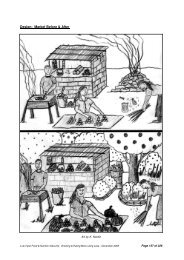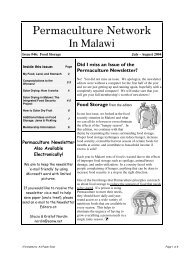Permaculture, Final Capstone Paper 5-26, Hope - Never Ending Food
Permaculture, Final Capstone Paper 5-26, Hope - Never Ending Food
Permaculture, Final Capstone Paper 5-26, Hope - Never Ending Food
Create successful ePaper yourself
Turn your PDF publications into a flip-book with our unique Google optimized e-Paper software.
The variable education was measured in number of years the participant attended school.<br />
In the Malawian education system, primary schooling is complete at 8 years. Two participants<br />
(7.4%) reported having never attended school while eleven participants (44.7%) did not complete<br />
primary school for a total of 52.1 % participants never having completed primary school. This<br />
statistic differs slightly from USAID’s calculation (2008) that 66 % of Malawians do not<br />
complete primary school but could be explained by the heavy distribution of participants who<br />
live within a twenty-mile radius of the capital city. Six participants indicated completion of<br />
primary school and 7 participants completed some level of secondary school. Two participants<br />
completed thirteen years of school as well as some college or technical school. No participant<br />
holds a Bachelors’ degree or higher.<br />
The variable certificate is a dummy variable, where 1 indicates that the participant holds<br />
a certificate from any kind of continuing education certificate course. This variable was included<br />
in order to discern if <strong>Permaculture</strong> adoption could be associated with continuing education, a<br />
factor that was hypothesized in discussions with the PNM. Sixty-six percent of participants (18<br />
of 27) has received at least one certificate of course completion in the following areas: computer<br />
skills, adult literacy, house painting, brick laying, life skills, community design, ANAMED<br />
(Action for Natural Medicine), accounting, empowerment skills, pastor education training,<br />
gender workshop, and <strong>Permaculture</strong> Nutrition/Design.<br />
Income was measured as a continuous variable. Participants’ monthly income ranges<br />
from 1000 Mk per month to 25,000 Mk per month, with a mean of 7200 Mk per month. The<br />
household characteristic, employed, is represented by a dummy variable where 1 indicates offfarm<br />
employment. According to Chirwa (2007) non-farm incomes provide farmers with<br />
additional resources, which may be used to purchase new technologies (p. 5), while, similarly,<br />
29



